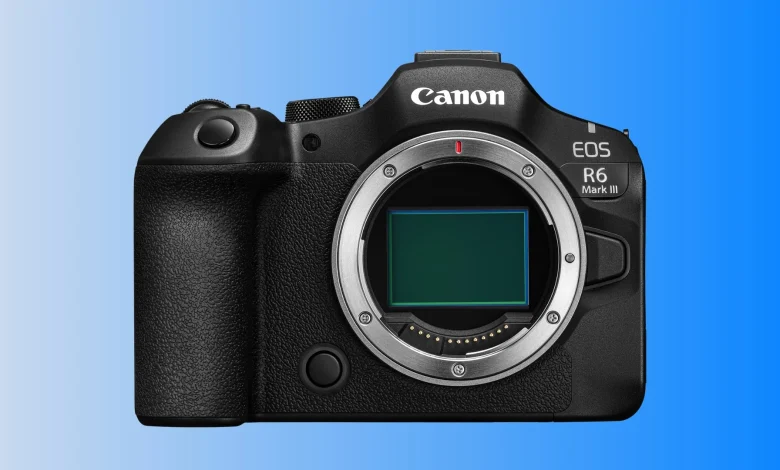Canon EOS R6 Mark III Announced – A New, Beefed-Up Hybrid Workhorse

Canon has announced the EOS R6 Mark III, the third iteration of its popular full-frame all-rounder. If you just want a quick TL;DR, the new camera is essentially an upgraded EOS R6 Mark II, a hybrid EOS C50, or a mix between the EOS R6 Mark II and the EOS R5 Mark II. The new Canon EOS R6 Mark III comes with a 32-megapixel sensor, better IBIS, improved tracking algorithms, and an enhanced video feature set with 7K open gate, internal RAW video, and a CFexpress card slot. Canon took a safe and proven track here—not fixing what isn’t broken, but refining and improving various elements.
Canon has long produced popular mid-tier cameras. After a relatively slow start in the full-frame mirrorless segment, the company announced the R5–R6 duo, aimed directly at professional photographers and hybrid creators. The next generation of both cameras cemented their position as a mainstream, mid-tier workhorse (EOS R6) and a high-resolution option, adhering to the emerging standard of 40+ MP / 8K cameras with the EOS R5 series. Now comes a camera that blends features and traits of both the EOS R5 and EOS R6—the Canon EOS R6 Mark III.
Canon EOS R6 Mark III. Image credit: Canon
Specs and features
At the heart of the Canon EOS R6 Mark III is a 32-megapixel, 7K-capable full-frame sensor. We can’t provide official confirmation regarding other cameras in which the sensor is used, but the specs seem closely aligned with the EOS C50. When writing my EOS C50 article, I did wonder how such a sensor first appeared in a cinema camera—well, it seems that question has now been answered.
And indeed, this sensor-processor image pipeline clears the way to an impressive stills machine:
- 32 megapixel images in both RAW, HEIF or JPEG
- DIGIC X image processor
- 7K RAW video up to 60p, 4K 120p, Full HD 180p
- Open Gate full-sensor recording with various frame markers
- Various 10-bit 4:2:2 video formats and frame rates
- Low-Pass filter
- 40 fps with electronic shutter, up to 20 images pre-burst
- New buffer can store up to 150 files
- CFExpress card will clear the buffer much quicker
- ISO range 100–64,000
- In-body image stabilization up to 8.5 stops in the center of the frame, 7.5 in the edges
- Dual Pixel CMOS AF II with enhanced subject recognition (people, animals, vehicles, trains, airplanes, horses)
Canon EOS R6 Mark III. Image credit: Canon
A budget EOS C50?
Not quite. While the EOS R6 Mark III boasts an impressive video feature set, it remains a hybrid camera and carries some well-known limitations associated with its stills-oriented, compact, and sturdy design.
Overheating is present, as the demanding motion-capture formats place a heavy load on the thermal management of the EOS R6 Mark III. Canon was transparent enough to provide overheating limitations, measured using the LCD screen, no communications, and no power over USB at 73°F / 23°C. Canon indicates that higher ambient temperatures, wireless LAN, power over USB, or live-view display active before recording may shorten recording times:
- RAW 60p + 2K proxy: Approx. 23 minutes on both “Standard” and “High” auto power off.
- 4K DCI “Fine” (oversampled): Approx. 23 minutes on both “Standard” and “High” auto power off.
- 4K DCI 120p: Approx. 28 minutes on “Standard”, 35 minutes on “High” auto power off.
- 7K Open gate MP4, 30p: Approx. 24 minutes on “Standard”, 36 minutes on “High” auto power off.
- 2K 180p: Approx. 120 minutes on both “Standard” and “High” auto power off.
- All other resolution/frame rates have no overheating limitation.
Canon EOS R6 Mark III top panel. Image credit: Canon
For those who remember the launch of the original Canon EOS R5, these numbers may sound familiar—if not slightly triggering. However, Canon does not market this camera as a video-first tool; quite the contrary. This is clearly a stills-hybrid camera capable of impressive video feats, but with significant limitations stemming from its intended use cases and compact design.
So, if you want the EOS R6 Mark III’s video specs without those recording limits, you’ll likely need to spend around $1,000 more and opt for the EOS C50.
Who is the Canon EOS R 6 Mark III for?
Almost anyone. The EOS R6 Mark III, like its predecessors, is a remarkably versatile tool. The added resolution and improvements make it better at nearly everything. While dedicated videographers and filmmakers may face record-time limitations at the most demanding formats, the camera offers the still-hybrid crowd nearly everything they could ask for. And if the price feels steep, Canon continues to offer the EOS R6 Mark II, further segmenting its lineup to meet varied needs.
Canon EOS R6 Mark III back panel. Image credit: Canon
Price and availability
The Canon EOS R6 Mark III is available for preorder and expected to ship in November 2025. It will be available as a body only for $2,799, as a kit with the Canon RF 24–105mm F4 L IS USM for $4,049, or with the more affordable RF 24–105mm F4–7.1 IS STM for $3,149.
Will you consider adding an EOS R6 Mark III to your kit? Would you use it for professional hybrid workflows or filmmaking? Let us know in the comments.





